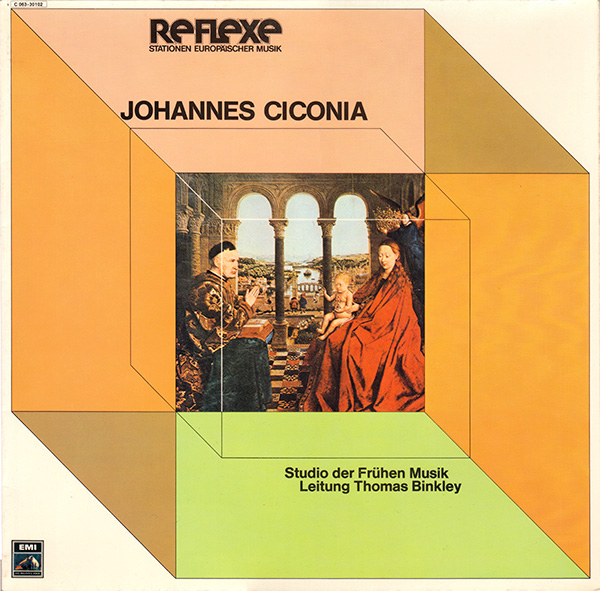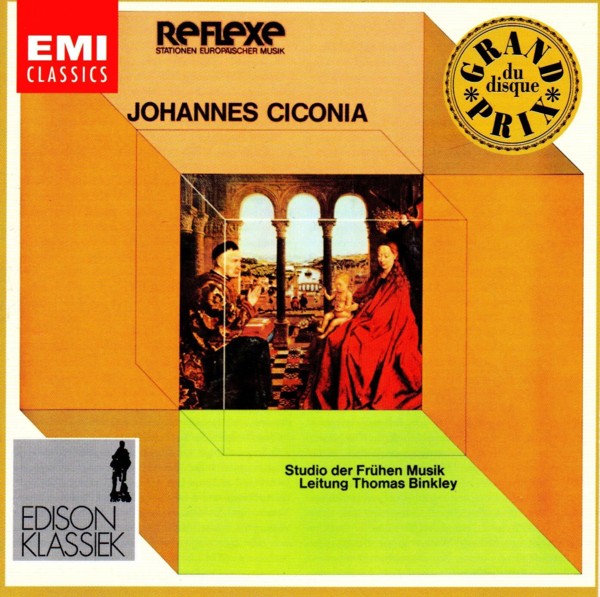
medieval.org
LP, 1972: EMI "Reflexe" 1C 063-30102
CD, 1991: EMI "Reflexe" CDM 7 63442 2

medieval.org
LP, 1972: EMI "Reflexe" 1C 063-30102
CD, 1991: EMI "Reflexe" CDM 7 63442 2
ITALIENISCHE WERKE
1. Una panthera [5:42]
Mezzosopran, Tenor, Fidel
2. Chi nel servir [3:11]
Mezzosopran, 2 Fideln
3. Lizadra donna [4:10]
Altus, Fidel, Sackbut
4. Per quella strada [3:48]
Mezzosopran, Tenor
5. O rosa bella [5:35]
Tenor, Fidel, Laute
FRANZÖSISCHE WERKE
6. Le ray au soleyl [1:50]
Mezzosopran, Tenor, Sackbut
7. Sus un' fontayne [5:57]
Mezzosopran, Fidel, Laute
8. Aler m'en veus [3:54]
Mezzosopran, Tenor
LATEINISCHE WERKE
9. Albane misse celitus [2:45]
Sopran, Mezzosopran, Sackbut I & II
10. Gloria [3:45]
Chor
11. Credo [5:38]
Chor

STUDIO DER FRÜHEN MUSIK
Thomas Binkley
Andrea von Ramm, Mezzosopran
Willard Cobb, Tenor
Richard Levitt, Altus
Sterling Jones, Fidel
Johannes Fink, Fidel
Thomas Binkley, Laute, Sackbut
Lucy Craig, Soprano
Klaus Renk, Sackbut
[CD]:
Produzent: Gerd Berg
Tonmeiste: Dieter Tomsen
Aufgenommen: XII.1970, Séon-Studio, München
Titelseite: Roberto Patelli
Ⓟ 1972 & Digital remastering Ⓟ 1991 by EMI Electrola GmbH
© 1991 EMI Electrola GmbH, D-5000 Köln

Johannes Ciconia c. 1370—1412
Ciconia's
music was something of a novelty when this record was first issued in
1972. His complete works had been published for the first time only ten
years earlier, by the Belgian scholar Suzanne Clercx. Professor Clercx
had also devoted much effort to uncovering details of Ciconia's life:
she clarified his central importance for music of the years around 1400,
and encouraged musicians — particularly the Studio der Frühen Musik —
in their performances of his works.
Since then, largely
stimulated by her efforts, musicians have become increasingly aware of
why Ciconia was called in his own time 'the most famous musician in the
world', how so many of his works are not only highly distinctive but
epoch-making. Scholars have built on Clercx's work and, inevitably,
reassessed some of her conclusions.
Born in Liège some time
around 1370, Ciconia is documented as a choirboy at the church of
St-Jean-L'Evangéliste in 1385. By 1391 he was in Rome, in the entourage
of a French cardinal. Later in the 1390s he was evidently at the
Visconti court in Pavia, as is shown by several important works: the
elaborately manneristic virelai Sus un' fontayne includes direct quotes from three songs by Philipoctus de Caserta; the madrigal Una panthera honours the delegation from Lucca that visited Pavia in 1399; and the canon Le ray au soleyl is built on Giangaleazzo Visconti's motto.
By
1401, however, Ciconia had corne to Padua, where he was to remain as a
singer, and later a canon, of the cathedral until his death in the
summer of 1412. Here he came into contact with the early Humanists,
several of whom he honoured in his works. He also appears to have
evolved the genre of the motet to commemorate an event of state; one
such is Albane misse celitus, written for the installation of Albano Michele as Bishop of Padua in 1406.1t must have been shortly afterwards that he set Lizadra donna, by the young Paduan poet Domizio Brocardo (c.1390—c.1448), and O rosa bella,
by the Venetian nobleman Leonardo Giustinian (c.1383—1446). Ciconia was
the first of the northern composers who were to dominate music in Italy
for the next two centuries: in a career of perhaps 20 years, he changed
the face of European music.
© DAVID FALLOWS, 1991